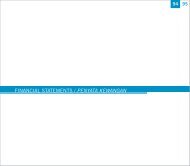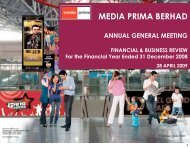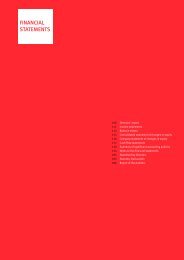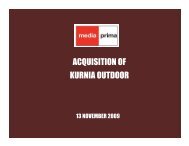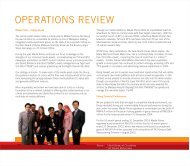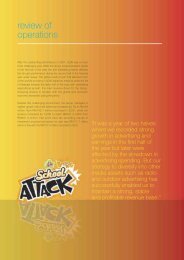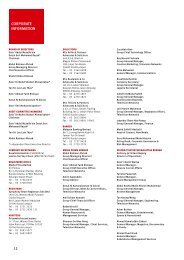2012 Annual Report - Media Prima Berhad
2012 Annual Report - Media Prima Berhad
2012 Annual Report - Media Prima Berhad
Create successful ePaper yourself
Turn your PDF publications into a flip-book with our unique Google optimized e-Paper software.
Z<br />
SEGMENT REPORTING<br />
Operating segments are reported in a manner consistent with the internal reporting provided to the chief operating<br />
decision-maker. The chief operating decision-maker, who is responsible for allocating resources and assessing<br />
performance of the operating segments, has been identified as the senior management and the Board of Directors<br />
that makes strategic decisions.<br />
AA FINANCIAL ASSETS<br />
(i)<br />
(ii)<br />
Classification<br />
The Group classifies its financial assets in the following categories: at fair value through profit or loss, loans<br />
and receivables, and available-for-sale. The classification depends on the purpose for which the financial assets<br />
were acquired. Management determines the classification of its financial assets at initial recognition.<br />
(a)<br />
Financial assets at fair value through profit or loss<br />
Financial assets at fair value through profit or loss are financial assets held for trading. A financial asset is<br />
classified in this category if acquired principally for the purpose of selling in the near term. Derivatives are<br />
also categorised as held for trading unless they are designated as hedges. The assets in this category are<br />
classified as current assets if expected to be settled within 12 months; otherwise, they are classified as<br />
non-current.<br />
(b) Loans and receivables<br />
(c)<br />
Loans and receivables are non-derivative financial assets with fixed or determinable payments that are not<br />
quoted in an active market. They are included in current assets, except for maturities greater than 12<br />
months after the end of the reporting period. These are classified as non-current assets.<br />
Held-to-maturity financial assets<br />
Held-to-maturity financial assets are non-derivative financial assets with fixed or determinable payments<br />
and fixed maturities that the Group’s management has the positive intention and ability to hold to maturity.<br />
If the Group were to sell other than an insignificant amount of held-to-maturity financial assets, the whole<br />
category would be tainted and reclassified as available-for-sale. Held-to-maturity financial assets are<br />
included in non-current assets, except for those with maturities less than 12 months from the end of the<br />
reporting period, which are classified as current assets.<br />
(d) Available-for-sale financial assets<br />
Available-for-sale financial assets are non-derivatives that are either designated in this category or not<br />
classified in any of the other categories. They are included in non-current assets unless the investment<br />
matures or management intends to dispose of it within 12 months of the end of the reporting period.<br />
Recognition and initial measurement<br />
RADIO OUTDOOR<br />
NETWORKS<br />
Regular purchases and sales of financial assets are recognised on the trade-date, the date on which the Group<br />
commits to purchase or sell the asset.<br />
Financial assets are initially recognised at fair value plus transaction costs for all financial assets not carried at<br />
fair value through profit or loss. Financial assets carried at fair value through profit or losses are initially<br />
recognised at fair value, and transaction costs are expensed in profit or loss.<br />
TELEVISION<br />
NETWORKS<br />
PRINT<br />
CONTENT<br />
CREATION<br />
NEW MEDIA<br />
171<br />
annual<br />
report<br />
<strong>2012</strong><br />
From Our Perspective Who We Are Our Strategy & Achievements Our Performance Our Responsibility Our Leadership Corporate Governance The Financials Additional Information




